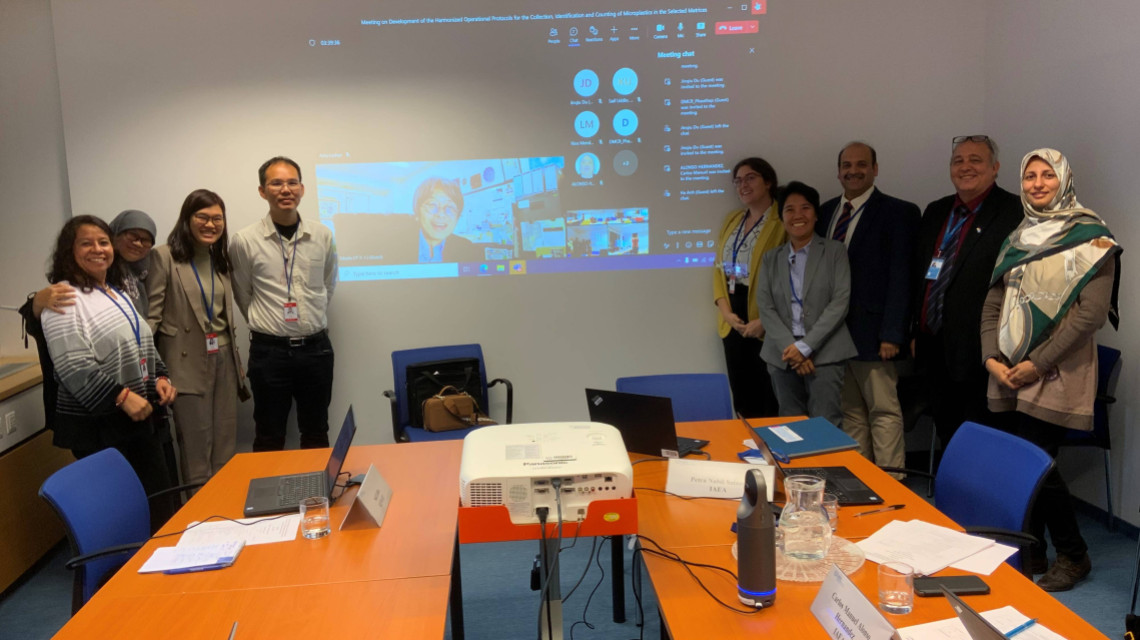The majority of microplastics, microbeads and single-use plastics in our oceans come from land-based sources and are transported to the sea from rivers and coastlines. Today, marine plastics affect more than 800 marine species and could potentially harm human health as these plastics enter our marine food chain. The need to radically reduce marine plastic pollution is specifically articulated in the United Nations' Sustainable Development Goal 14. However, experts have found it challenging to reach conclusions about the presence and distribution of ocean plastics in their regions, because of different sample collection and preparation techniques, as well as the different units used to measure and log results.
To help harmonize guidelines for the sampling, separation and identification of microplastics in beach sands, seawater and marine sediments, the IAEA within its NUTEC Plastics initiative held a regional meeting with experts in Asia and the Pacific on 15-18 November 2022. NUTEC Plastics supports marine monitoring, using isotopic tracing techniques.
"A harmonized protocol for microplastic monitoring is vital for my country to strengthen its efforts to combat this emerging concern and understand the sources or sinks of microplastics in the environment," said Norman Mendoza, a Senior Science Research Specialist at The Marine Science Institute, University of the Philippines who attended the regional meeting.
Through an ongoing regional technical cooperation (TC) project[1], the IAEA is helping countries in the western Pacific rim to develop harmonized criteria and standards to ensure proper generation of their marine plastic pollution data and analysis, and eventually that their conclusions are well-aligned. This in turn will equip government decision-makers with the tools needed to develop and institute evidence-based policies to mitigate the effects of climate change.

Nine experts from countries in Asia and the Pacific, as well as two experts from Norway and the United States of America, shared their experiences in microplastics monitoring at the regional meeting. (Photo: P. Nabil/IAEA)
At the meeting, nine experts from countries in Asia and the Pacific and two experts from Norway and the United States of America shared their experiences in microplastics monitoring and collaboratively explored the proposed protocols underpinning the project's new harmonized approach. Discussions addressed the materials, reagents and equipment required to initiate monitoring across the region, and explored the potential of IAEA support to help develop the necessary capacity for their use.
"Harmonised protocols for monitoring allow researchers and nations to modify their approaches depending on their own situation, yet still generate comparable data," said Amy Lusher, a researcher in the field of marine pollution from Norwegian Institute for Water Research. "To me, harmonisation means having the flexibility to adapt methods and putting effort towards validation."
The regional meeting concluded with the finalization of draft protocols for sample collection and preparation, with agreement that microplastics samples will be collected from sand, seawater and marine biota. "It's a long way to go for Microplastic Research. A harmonized protocol for the study of microplastics is a leap in the right direction," said Saif Uddin, a Senior Research Scientist from Kuwait Institute for Scientific Research
The new draft protocols will be shared among the participating IAEA member countries in Asia and the Pacific, before being finalized at a regional workshop to be held in Thailand in April 2023.
[1] RAS7038, 'Monitoring the Marine Environment for Enhanced Understanding of the Abundance and Impact of Marine Plastic Pollution'






